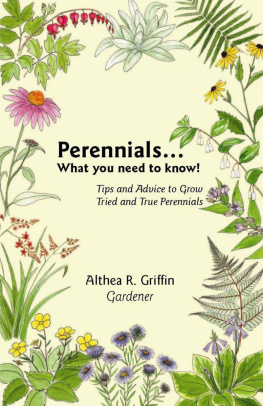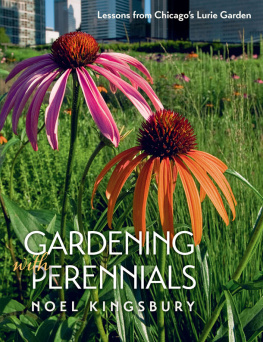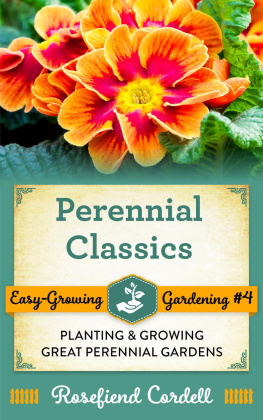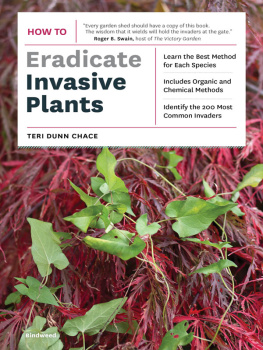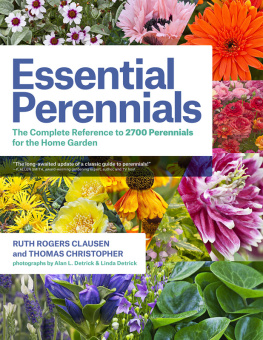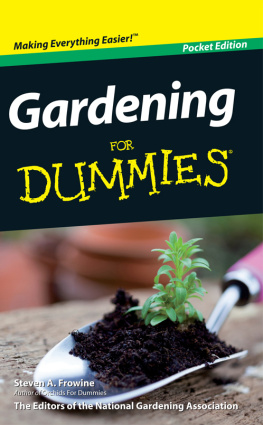10 Easy-Care Perennials
Marcella Shaffer
CONTENTS
Introduction
Perennials are the wonder of the garden world and the heart of most flower gardens. They are well loved for the kaleidoscope of colors they offer, revered for their ability to flower and spread year after year, and treasured for the beauty of their form, texture, and foliage. They invite birds, butterflies, honeybees, and humans alike to come closer and admire their elegance and charm. They are the delight and passion of gardeners around the world.
There are thousands of garden perennials, and even more varieties are developed every year. Some are flashy and showy, dressed in screaming colors and exotic shapes. Others are simple yet elegant, expressions of a subtle beauty found in delicate foliage and geometric form. Some bear the dubious beauty of careful breeding, with giant showy heads that must be staked and propped. Others remain true to their hardy wildflower roots, with small perky blossoms that need no more than admiration. Some are robust and flexible, happy to grow just about anywhere theyre planted. Others are more temperamental, tending to sulk and droop if not pampered and petted.
The selection is more than enough to stump the beginning gardener or the flower enthusiast who hasnt much time to spend weeding, watering, and otherwise working in the garden. But thats what this bulletin is all about: narrowing down the selection. Easy-care perennials are terrific garden plants. They grow quickly, require little maintenance, and, for rent of a little space in your yard, remunerate you with bright blooms and gorgeous foliage year after year. No fuss, no muss, and plenty of beautiful flowers!

A bed of perennials helps a small specimen tree blend into the landscape.
Ten EasyCare Perennials
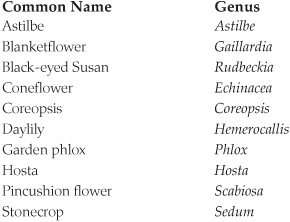
Why Perennials?
If you are new to the world of gardening or have grown only annuals in the past, you may not be aware of the many benefits that growing perennials can offer. Although perennials are often interplanted with annuals, they are certainly capable of standing alone. Indeed, many growers have gardens comprised entirely of perennials, and avid perennial fans wouldnt dream of growing anything but these wonderful plants.
Except in the more temperate zones, a perennial usually dies back each year after a hard frost and after freezing temperatures have set in. Some, like bleeding heart, go dormant in the summer. The following spring it sends up new green shoots and starts its growing and flowering cycle all over again. Some perennials live for only a few years, while others remain vital and attractive even when decades old.
Most perennials are self-propagating and multiply on their own, increasing in beauty and size each year. If they begin to overgrow their allotted space in the garden, they can usually be divided without too much trouble, then replanted elsewhere in the garden or shared with friends and fellow gardeners.
Though perennials initially cost more than annuals to purchase, they are actually less expensive over the long term, because you dont have to buy new ones every year, and if you want more plants, you can simply divide or take cuttings from your existing perennials. Growing perennials can also be a time saver, because they dont require replanting each year.
Many perennialsincluding the ones featured in this bulletinare undemanding, wonderfully versatile, and adaptable to a variety of growing conditions. They can grow in poor soil or good soil and can survive both drought and overwatering, as long as they have drainage. Some perennials flourish in full sun, while others prefer deep shade, but generally all perennials can be grown in a partly shaded area. Though commonly thought of as garden bed plants, many species of perennials are suitable for growing in containers on a deck, porch, or patio. This versatility expands the growing options when gardening space is limited.

With their vivid colors, beautiful blooms, and bountiful foliage, perennials add exuberance and liveliness to the landscape.
Know Your Plants
Its important to know the definitions of the various plants. An annual completes its entire life cycle in one growing period: It grows, flowers, and dies all within one growing season. A biennial lives for two years, growing the first year, then blooming and dying the second. The wonderful perennial grows and blooms each and every year and forms seed with every blossom.
Ten Outstanding Easy-Care Perennials
What makes these ten perennials the best in easy care? Not only are they beautiful and hardy, but they also have an undemanding nature, yielding great rewards for very little care. Most come in numerous varieties, offering a whole palette of colors and foliage for your garden design.
Astilbe (Astilbe spp.)
Prized for both its foliage and its flowers, astilbe is one of the most spectacular plants available for semishady places in the garden. Astilbes work well in the garden as border or accent plants, and when mass planted in groups of three or more, the effect is stunning. Astilbes also make excellent cut flowers, plus they dry attractively for dried flower arrangements. Some gardeners enjoy astilbe flowers during the winter by forcing a newly potted start taken from the mother plant after dormancy.

HARDINESS:
Zones 3-9
SOIL REQUIREMENTS:
Moist, well-drained, humus-rich soil
LIGHT REQUIREMENTS:
Partial shade
WATER REQUIREMENTS:
Keep soil moist
SPACING REQUIREMENTS:
Set plants 18 to 24 inches (45-60 cm) apart
PROPAGATION:
By division in spring or fall
Astilbe has lovely, abundant, dark green fernlike foliage and produces flowers on long spikes, resembling feathery plumes, that soar over the leaves. Individual blossoms are minuscule, but each plume contains dozens of branches, with each branch bearing hundreds of flowers. Hardy in Zones 3 to 9, astilbe prefers partial shade, producing its most colorful flowers and lushest foliage when receiving morning sunshine and shade during the hottest part of the day. Astilbe prefers evenly moist soil that has been enriched with organic matter such as compost or leaf mold. Dry soil causes the plant to fade and wither. Depending on the species and variety, the mound-shaped astilbe reaches from 1 to 3 feet (45-90 cm) in height and spreads to 2 feet (60 cm) in width. Blooming time also depends on the variety, but each variety provides several weeks of color.
Astilbe is a heavy feeder and should be given a high-phosphorus fertilizer each spring. Because of rapid spreading, astilbe can quickly become overcrowded, resulting in sparse blooming. Rejuvenate the plants by dividing them in early spring or autumn every two to three years.
Astilbe is available in many varieties, including:



